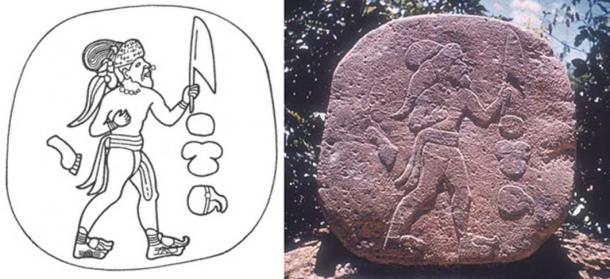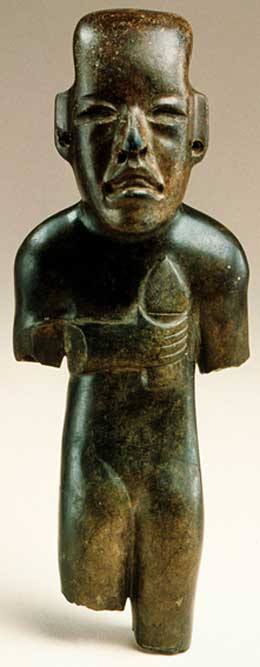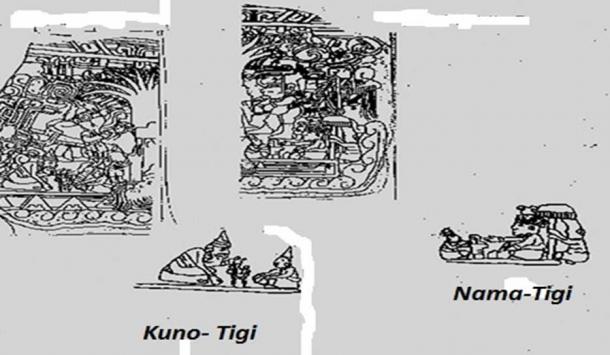
Birds, Stones, and Jaguars: Piecing Together the Multifaceted Ancient Olmec Religion
The Bilingual-Mayan inscription of Comalcalco and decipherment of the La Venta celts and Olmec iconography allows one to understand much about the ancient Olmec religion and its cult associations. Specifically, the major sources of information on the Olmec religion are La Venta Monument 13 and the Book of Chumayel.
The principal Olmec cult associations were those of the bird and the feline. These Olmec religious traditions passed on to the Maya. They are mentioned in the Book of Chumayel, which was translated by Brotherston. It maintains that the three main cult associations that existed in ancient times were (1) the stone (cutters) cult, (2) the jaguar cult, and (3) the bird cult. In lines 4-6 of the Book of Chumayel, one reads that “Those with their sign in the bird, those with their sign in the stone, flat worked stone, those with their sign in the Jaguar-three emblems.”

Spanish edition of the ‘Book of Chumayel.’ (Melinda Stuart/CC BY NC ND 2.0)
Documents in Stone
The Olmecs left testimony to their religious traditions in their art. Their documents on stone indicate that the cult associations mentioned in The Book of Chumayel correspond to the gylphs depicted on Monument 13 at La Venta.
Monument 13 at La Venta shows a personage in profile. He wears a headdress and a breechcloth, jewels, and sandals. This image is accompanied by four glyphs listed one above the other. The glyphs include stone, jaguar, and bird emblems. Monument 13 at La Venta also has a fourth sign to the left of the personage - foot gylphs. This monument has been described as an altar or a low column.
- Does the Cascajal Block provide evidence of a written language of the Olmecs?
- The Stone Head of Guatemala that History Wants to Forget
- Forgotten Stones: Secrets of the Megalithic Quarries

Monument 13 at La Venta. (ancient-wisdom)
In Olmec, the foot is called "se", this symbol means to "lead or advance toward knowledge, or success." The "se" sign of the komo (cult) represents the beginning of the Olmec initiate’s pursuit of knowledge.
Reading from top to bottom, the symbols on Monument 13 are: a circle kulu/ kaba (stone), nama (jaguar) and kuno (bird). The interpretation of this column while reading from left to right is "The advance toward success--power--for the initiate is obedience to the stone cutters cult, jaguar cult, and the bird cult". It is also interesting to note that the jaguar mask association dominated the Olmec Gulf region.
The Role of the Komo
The Olmecs believed that their ancestors transformed into birds and jaguars (felines). This tradition led to the origin of the two major Olmec cult associations - Kuno (Bird) and Nama (Feline). These associations were called Gyo/Jo.
The Nama initiatory society was organized to maintain order within society. The members of this Jo were to ensure ceremonial unity and defeat sorcery. The leader of the Nama Jo wore a mask which combined totems of the komo and horns. The mask represented immense spiritual power.
The komo was administered by sculptors. Their role was to guard society from people committing antisocial acts and protect people from malevolent spirits. The leader of the Jo cult association was the Komo-tigi ‘chief of the komo.’ The komo taught initiates leadership, self-sufficiency, military prowess, and scientific knowledge. The komo also acculturated Olmec children. Thus, the children in the komo were called tigi-denw: ‘children of the tigi.’ These children often served as tigi-tuguw “carriers of the torches.” It is important to note that the image of the flame signified the luminous character of knowledge for the Olmecs. The torch-bearing children also belonged to the ntomo or n’domo. The ntomo association was charged with making the initiates “noble.”

Sculpture of an Olmec child holding a torch. (estudi-arte)
Bird and Jaguar Cults
In the central and southern Olmec regions, one finds that the bird mask association predominates - as typified by the Xoc bas relief of Chiapas, and the Bas Relief No. 2 of Chalcatzingo. Another bird mask cult association was located in the state of Guerrero, as evidenced by the human-bird figure of the stelae from San Miguel Amuco.

Left: Xoc Bas Relief from Chiapas. (Book of Mormon Resources) Right: Drawing of a human-bird figure from San Miguel Amuco. (intrest.ru)
Izapa Stela No. 5 also depicts the Olmec cults. They represented the traditional leaders of the Bird and Jaguar cults on this stela.

A drawing of Izapa Stela No. 5. (Madman2001/CC BY 3.0)
The religious orders shown on Stela No. 5 are also mentioned on Monument 13. These Olmec cults were Nama, or the Human-Jaguar cult; and Kuno, or the Bird cult. The leader of the Nama cult was called the Nama-tigi, or Amatigi (head of the faith). The leader of the Kuno cult was the Kuno-tigi. These cult leaders initiated the Olmecs into the cults’ mysteries.

The Olmec Cults represented on Izapa Stela No. 5. (Author Provided)
Adults and Children in the Cults
The Kuno priest wears a conical hat. This hat is important evidence of ancient Mesoamerican religions. In Africa and the Discovery of America (1922, v.II: p.321), Leo Wiener asserts that the conical hat in Mesoamerica is associated with Amerindian priesthood and is a symbol of political and religious authority.
Acculturation of children was an important duty for the Olmec priesthood. As a result, one finds many depictions of children being provided knowledge by Olmec priests.
- The mysterious civilization of the Olmecs
- Possible sacred maize object found in stream at Olmec site
- Olmecs, Ancient American Civilization with African Characteristics

Children and Olmec priests. Bas-relief on the left side of Altar 5 from La Venta. (Ruben Charles/CC BY 2.0)
The child is very evident in Olmec art. To the Olmecs, childhood represented the primitive state of mankind, when man was pure and ignorant of nature. Thus, children also symbolize human beings when they left their creator’s hands: uncircumcised and androgynous.
Adults respected children very much in the Olmec culture. This view is supported by the motifs on Altar No. 5 of La Venta - the Altar of Children. On this monument, one sees a person emerging from the stone altar with the glyph po gbe ‘Pure Righteousness’ on his headdress. He is carrying a babe in his arms resting on his lap.

A frontal view of Altar No. 5 from La Venta. (Ruben Charles/CC BY 2.0)
On the other side of the Altar of Children one can see two people, each with a different helmet style. These scenes suggest that the Olmec child was learning wisdom, as illustrated by the animated conversation between the child and the priest.
A priest and child are shown once again on the right-hand side. This time the priest has a snake on his helmet. Instead of carrying the child on his lap in this scene, the child is carried on the person’s side and is wearing a jaguar mask. This indicates that once the child completed the initiation he was recognized as an individual to be respected and could give advice to adults.

Las Limas Monument 1, a greenstone figure of a youth holding a human-jaguar (were-jaguar) baby. This sculpture was found in Veracruz, Mexico. (O Cadena/CC BY SA 2.0)
In summary, the Olmec religion consisted of two principal cults: the Bird and Human-Jaguar cults. In addition to these cults, the Olmecs had an initiation tradition that socialized the children into society. The tradition of child-initiation did not die with the Olmec people. It can be seen in Room 1 murals at Bonampak, for example, where a priest is depicted with a child - just like in Olmec iconography.

Detail of a Maya Bonampak mural. Note the priest and child on the upper right side. (Boston University)
Top Image: Representation of the Olmec sky god "Itzamnaaj". Temple VI, Comalcalco, Tabasco, Mexico. Source: Alfonsobouchot/CC BY SA 4.0
References:
Brotherston, G. (1979). Image of the New World.
Clyde Winters. (2011). Olmec (Mande) Loan Words in the Mayan, Mixe-Zoque and Taino Languages. Current Research Journal of Social Sciences 3(3): 152-179. http://maxwellsci.com/print/crjss/v3-152-179.pdf
Winters, Clyde. (2015). Olmec Language and Literature. Createspace. https://www.amazon.com/Olmec-Language-Literature-Clyde-Winters/dp/1507587244
Winters, Clyde. (2016). Archaeological Decipherment of Ancient Writing Systems. https://www.amazon.com/Archaeological-Decipherment-Ancient-Writing-Systems/dp/1532967365
Wuthenau, A. von. (1980). Unexpected Faces in Ancient America. 2nd Edition. Mexico.















